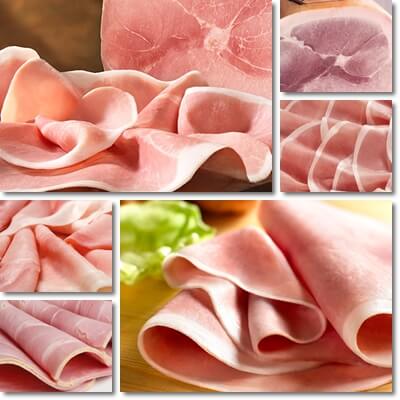Prosciutto cotto is a specialty Italian ham of international recognition. It is the cooked version of the famous Italian salt-cured and dried DOP ham known as prosciutto crudo. As opposed to prosciutto crudo which is salt-cured and dried uncooked ham, prosciutto cotto is a salt-cured and cooked ham of the utmost quality.
An Italian delicacy par excellence, prosciutto cotto is high-protein and a good dietary source of copper, phosphorus, potassium, selenium, zinc, choline and several B vitamins. On the downside, prosciutto cotto is high-sodium and high in histamine, a moderate source of fat and cholesterol, with a moderate energetic value.
Unless premium quality, with certification, it will contain additives with allergenic potential, as well as preservatives such as nitrites and nitrates.
What is prosciutto cotto?
Prosciutto cotto is a cooked Italian ham of international recognition. It is a salted and dry-cured, cooked ham, although much more exquisite and healthier than your regular deli ham. It falls under the category known as salume (pl. salumi), meaning Italian specialty cold cuts made primarily from pork meat (with a few exceptions).
Prosciutto cotto is made exclusively from pork meat, more specifically from the top part of the back leg of a pig (that is, from pig hind leg thigh). Varieties of prosciutto, cotto or crudo, can be made from other types of meat as well, but legislation requires that the animal be mentioned on the label (e.g. wild boar prosciutto, lamb prosciutto). However, original, certified prosciutto cotto is made exclusively from pork hind leg.

How is prosciutto cotto made?
Just like DOP prosciutto crudo, prosciutto cotto is made following a time-honored traditional process that ensures a high-quality charcuterie product of exquisite taste. Selected pig hind leg thighs are used for making prosciutto cotto. The bone is taken out, but the pork rind is kept on the meat. The boneless pig leg with skin is salt-cured which helps remove some of the moisture and blood and inhibit bacterial growth, then shaped in a mold to give it its rounded appearance.
Afterwards, the ham is steam-cooked – the number of cooking hours depends on the size (weight) of the ham.
The cooked ham is then pressed and left to cool at room temperature, then refrigerated until packed and sent out to stores. The cooked ham may also be pasteurized, depending on legislation.
High-quality prosciutto cotto shouldn’t have any preservatives other than salt. However, various spices and herbs may be added to improve flavor or create specialties. For example, white pepper, black pepper, juniper, bay leaves, even truffles and more herbs and spices may be used. Lower-quality options may contain nitrites, nitrates and various stabilizers, flavor enhancers, emulsifiers, acidity regulators etc. Low-quality prosciutto cotto is also often adulterated with soy protein, milk solids or milk protein or gelatin.
What does prosciutto cotto look like?
Prosciutto cotto is roughly round-shaped or rectangular-shaped with rounded corners. It is a big block of meat, as heavy as as 7-8 kg and up to 12 kg or more. On the inside, the cooked ham is several shades of pink with thin, white pork fat veins that give it a marbled appearance. Each block of ham has a thicker band of white pork fat near the tan rind made of pork skin. For the best taste experience, prosciutto cotto is eaten finely sliced, either cold or at room temperature.

What does prosciutto cotto taste like?
As opposed to prosciutto crudo, which has a more intense flavor and a bit of a stringier texture, prosciutto cotto has a more delicate taste, with light pork flavors. While compact and dense, it is moist and tender, and doesn’t taste too salty, despite being a cured ham. Overall, it is quite exquisite-tasting. As opposed to prosciutto crudo, which is served uncooked, prosciutto cotto is cooked, which adds new dimensions to its texture and flavor profile and the entire taste experience.
What are the different types of prosciutto?
There are several major types of Italian prosciutto ham, including:
- Prosciutto crudo, with international DOP or PDO and PGI or IGP certification.
- Prosciutto cotto, without DOP/PDO or PGI/IGP certification, but still a recognized international Italian product. In Italy, prosciutto cotto has Prodotto agroalimentare tradizionale (PAT) certification, meaning it’s a recognized traditional Italian regional food product.
- Other varieties (with PAT recognition): prosciutto affumicato (smoked prosciutto ham), prosciutto contadino (peasant prosciutto), prosciutto di pecora (sheep prosciutto), prosciutto di spalla (shoulder prosciutto), prosciutto cotto al vino (prosciutto cotto with wine), prosciutto dolce (sweet prosciutto) etc.
Prosciutto cotto vs prosciutto crudo
The biggest difference between the two types of prosciutto is in the name: prosciutto cotto is cooked (‘cotto’), whereas prosciutto crudo is raw or uncooked (‘crudo’). But there are other differences as well. For example, while both types of prosciutto are salt-cured, as per the traditional recipe, prosciutto crudo typically goes through at least 2 salting cycles, depending on the variety of prosciutto.
Prosciutto cotto takes a lot less time to make, whereas prosciutto crudo is cured and aged for at least 12-13 months. The highest quality prosciutto crudo is aged around 2-3 years, developing an internationally prized flavor.
Prosciutto cotto is several tones of pink with thin, white pork fat veins throughout, in a beautiful pink-marbled design (it’s not a uniform color like mortadella). Each ham has a white band of pork fat towards the exterior, near the rind. The texture is soft, tender and the consistency dense and compact; the taste is mild in intensity, lightly salty, with delicate, cooked pork flavors.
By comparison, prosciutto crudo is on the redder side, pink red and red, again, in various tones, with a white band of pork fat and several smaller veins of fat throughout.
The ham is compact, slightly stringy, but tender, with a more pronounced taste than prosciutto cotto and rich, aged pork flavors that differ depending on the region where the ham originates.
Prosciutto crudo made in certain provinces and regions of Italy, according to traditional recipes, ensuring it acquires unique properties, boasts a DOP (Denominazione di origine protetta) or PDO (Protected Designation of Origin) status which is a certification of quality, tradition and traceability. Versus prosciutto crudo which does not have DOP or PDO status, but is still an international recognized traditional Italian salume.
In Italy, prosciutto cotto has Prodotto agroalimentare tradizionale (PAT) certification, meaning it’s a recognized traditional Italian regional food product.
